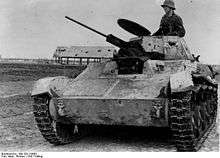T-60 tank
| T-60 scout tank | |
|---|---|
|
T-60 at the Kubinka Tank Museum | |
| Type | Light tank |
| Place of origin | Soviet Union |
| Service history | |
| In service | 1941–45 |
| Used by |
Soviet Union Nazi Germany (captured) |
| Wars | World War II |
| Production history | |
| Designer | Nicholas Astrov |
| Designed | 1938–41 |
| Manufacturer | Factory 37, Moscow, GAZ, Gorkiy, Factory 38, Kirov |
| Produced | 1941–42 |
| No. built | 6,292 |
| Specifications ([1]) | |
| Weight | 5.8 tonnes |
| Length | 4.10 m |
| Width | 2.30 m |
| Height | 1.75 m |
| Crew | 2 |
|
| |
| Armor | 7–20 mm |
Main armament | 20 mm TNSh cannon (750 rds.) |
Secondary armament | 7.62 mm coax DT machine gun |
| Engine |
GAZ-202 6-cylinder 70 hp (52 kW) |
| Power/weight | 12 hp/tonne |
| Suspension | torsion bar |
| Fuel capacity | 320 l |
Operational range | 450 km |
| Speed | 44 km/h |
The T-60 scout tank was a light tank produced by the Soviet Union from 1941 to 1942. In this time 6,292 were built. The tank was designed to replace the obsolete T-38 amphibious scout tank.
Design

Nicholas Astrov's design team at Moscow Factory No. 37 was assigned the task of designing amphibious and non-amphibious scout tanks in 1938. They produced the T-30A and T-30B prototypes. The former was to be manufactured as the T-40 amphibious tank starting in 1940. It also led to the T-40S (sukhoputniy, "dry-land" version), a heavier tank prototype which was considered too complex to manufacture. The T-30B prototype, sharing the T-40's chassis but simpler in construction and with heavier armour, was accepted as the T-60 scout tank, and production began in July 1941, just after the German invasion.
Although at first intended to carry a 12.7 mm machine gun like the T-40, the armament was later upgraded to the 20 mm TNSh cannon, a tank version of the ShVAK, on the advisement of the People's Commissar for Tank Industry Vyacheslav Malyshev. This weapon could penetrate 15 mm of perpendicular armour at 500 m which proved inadequate against the newer up-armoured German tank designs, thus attempts were made in 1942 to re-arm the T-60 with the 37 mm ZIS-19 cannon, but were abandoned due to the Soviet Union's shortage of 37 mm ammunition. Due to this a new project was started to house the standard 45mm tank gun on a modified turret. That became impossible, and a new turret was designed and tested successfully in the summer of 1942. The new turret had the gun moved to its right side to make more room for the crew member and a co-axial machine gun was added. The project was terminated when Stavka chose the recently produced T-70 as the new standard light tank.
A number of T-60s were captured and pressed into German use as the Panzerkampfwagen T-60 743(r).
The T-60 was also used in the design of the experimental T-90 antiaircraft tank.
Gliding tank
One T-60 was converted into a glider in 1942 and was designed to be towed by a Petlyakov Pe-8 or Tupolev TB-3 bomber and was to be used to provide partisan forces with light armour. The tank was lightened for air use by removing armament, ammunition, headlights and leaving a very limited amount of fuel. Even with the modifications the TB-3 bomber had to ditch the glider due to the T-60's poor aerodynamics during its only flight to avoid crashing. The T-60 landed on a field near the aerodrome and after dropping the glider wings and tail returned to its base. Due to lack of sufficiently powerful aircraft to tow it the project was canceled and never resumed.
Romanian TACAM and Mareșal tank destroyers
The Romanians modified 34 captured T-60s into TACAM T-60 tank destroyers in 1943. They were armed with captured Soviet 76 mm divisional gun M1936 (F-22) housed in a light armoured superstructure open in its top and back, a typical configuration in the tank destroyers at the time. All surviving vehicles were confiscated by the Soviets after Romania defected to the Allies in August 1944.
The Romanian military began development of an armoured fighting vehicle at the end of 1942, the Mareșal tank destroyer. The design inspired the development of the German Jagdpanzer 38 light tank destroyer. Later prototypes mounted the Romanian 75 mm Reșița Model 1943 anti-tank gun and were powered by a French-made Hotchkiss engine. All prototypes were later confiscated by the Soviets and no further work allowed after Romania shifted sides.[2]
References
Sources
- Miller, Steven (2000). Tanks of the World: From World War I to the Present Day. Osceola, WI: MBI Publishing. ISBN 0-7603-0892-6.
- Zaloga, Steven J.; James Grandsen (1984). Soviet Tanks and Combat Vehicles of World War Two. London: Arms and Armour Press. ISBN 0-85368-606-8.
External links
| Wikimedia Commons has media related to T-60. |
- T-60 Development History and Combat Employment Battlefield.ru
- T-60 tanks, T-60 tanks in museum and monuments
